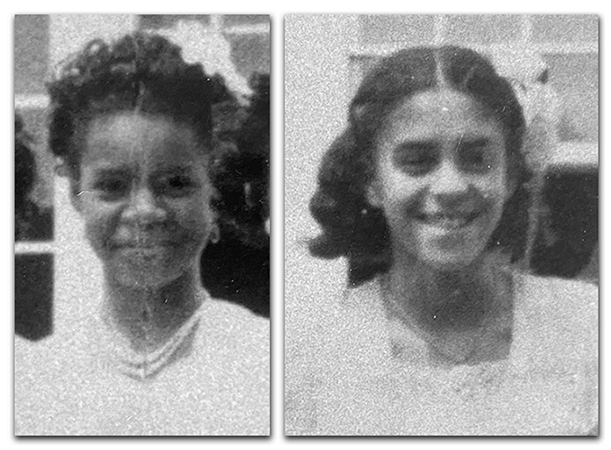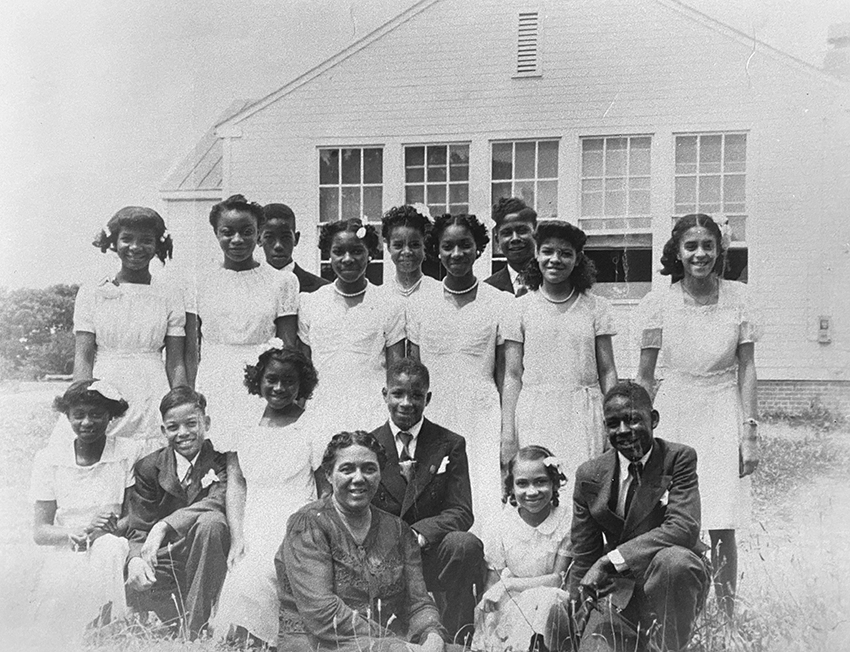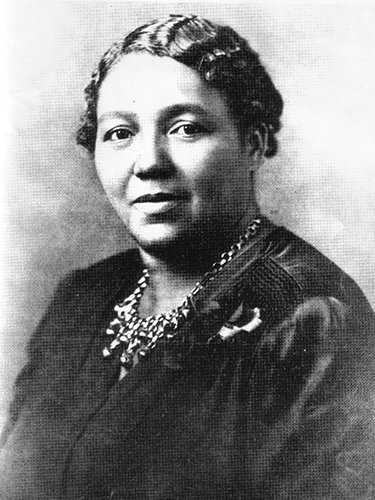Our History (1939-1948)
A Note on Language
When you research the history of Fairfax County Public Schools (FCPS) during the period of 1870 to 1970, you will invariably encounter racially-charged language that is archaic and often problematic by modern standards. In particular, the primary source documents from the period use the terms “colored” and “Negro” to commonly describe students and schools. In the following text, the word colored is being used in its historically correct context.
The Vienna Colored School
Louise Archer Elementary School opened in September 1939, but at that time our school had only three classrooms and it went by a different name—the Vienna Colored School. When Fairfax County Public Schools (FCPS) was founded in 1870, Virginia law required localities to operate separate public schools for white and African-American children. The Vienna Colored School was the Town of Vienna’s public school for African-American children. Prior to the start of the 1939-40 school year, African-American children living in Vienna attended a schoolhouse located at the intersection of Lawyers Road and Malcolm Road. In her book “Louise Archer: The Educator and the School,” historian Sylvia B. Taylor wrote:
The parents, under Mrs. Archer’s prodding, realized that the school size was inadequate, so a vigorous fundraising campaign was launched beginning in 1935. The School League purchased an acre of land on Nutley Street from Captain and Mrs. B. F. Salsbury. The Salsburys donated another acre. These two acres combined were deeded directly from the Salsbury family to the School Board in 1938. It is unfortunate that in this transaction, there was no official record of the purchase made by the School League.

From 1933 to 1944, the Federal Government’s Public Works Administration (PWA), created in response to the Great Depression, funded the construction of airports, bridges, dams, hospitals, and schools throughout the United States. In 1938, the Fairfax County School Board applied for a grant from the PWA to fund the construction of new schools for African-American children at Gum Springs, Merrifield, and Vienna. The grant request was approved, and, in April 1939, the School Board awarded the contract for the construction of a school on the two-acre Salsbury lot to contractor C. E. Nuckols of Richmond, Virginia.

The First Year
Louise Archer Elementary School’s legacy of providing the best education possible to all students began with three women, namely Louise Reeves Archer, Mabel Thomas Mack, and Channie Catlett Henderson. These women were the first educators at the new Vienna Colored School when it opened in 1939. Click on each of their names below to get a glimpse inside their classroom during the 1939-40 school year.
Louise R. Archer
Annual Salary: $635.00
Grades: 5-7
Enrollment: 38
Ages: 11-16
Classroom: 38 single desks, one teacher’s desk, a stove, piano, wash stand, wash basin, water cooler, stationary, one globe.
Classroom Library: No dictionary, two sets of encyclopedias, 83 books.
Special Units Taught: The Teeth, Pre-historic Man, U.S.A., Diphtheria, Sanitation.
*Sources: FCPS Term Reports and School Board Minutes.
Mabel T. Mack
Annual Salary: $590.00
Grades: 3-4
Enrollment: 37
Ages: 8-11, and a few teenagers.
Classroom: 34 single desks, one teacher’s desk, a stove, one globe.
Classroom Library: No dictionary, no encyclopedias, 36 books.
Special Units Taught: Sanitation, Diphtheria.
*Sources: FCPS Term Reports and School Board Minutes.
Channie C. Henderson
Annual Salary: $590.00
Grades: 1-2
Enrollment: 42
Ages: 6-9, and a few pre-teens.
Classroom: 40 single desks, eight chairs, one teacher’s desk, a stove, washing stand, and a glass rack.
Classroom Library: One dictionary, one encyclopedia, 85 books.
Special Units Taught: Mother Goose (Grade 1), Sanitation – Home and School Water Supply.
*Sources: FCPS Term Reports and School Board Minutes.
The first year in the new school was an exciting one for the students and teachers. On Sunday, October 1, 1939, a dedication ceremony was held, and the community turned out in droves to celebrate the opening of the school. In November, the students were visited by a dental clinician from Fairfax County who examined and cleaned the children’s teeth. In the fall, families from the Cartersville community, with assistance from Principal Archer, purchased a used school bus. Some of the students who attended the Vienna Colored School lived in distant rural communities, such as Cartersville and Woodentown. The school bus was a tremendous blessing to these children and their families because the great distance the children had to travel to and from school each day had kept many children from pursuing their education. In December, the students put on a Christmas musical, and, in January 1940, a luncheon was held to raise funding for the installation of electricity in the school. In the springtime, the children celebrated May Day and graduating seventh graders were feted with a ceremony and banquet at the First Baptist Church of Vienna.
School Days
Children at the Vienna Colored School in its early years went without many of the modern conveniences students might take for granted today, such as indoor water, indoor bathrooms, and air conditioning. In February 2020, we interviewed three former students who attended the Vienna Colored School in the 1940s. The ladies shared some memories of the schoolhouse, their teachers, and the typical school day.

The Baby Boom Begins
In 1943, the School Board shifted the school attendance boundary between the Odrick’s Corner School and the Vienna Colored School, reassigning the East Woodford community near Dunn Loring to Vienna. On Friday, January 28, 1944, the school hosted a ball in celebration of President Roosevelt’s birthday. The event featured a live orchestra performance and dancing. In September 1946, Lucien Stotts was appointed the first custodian of the Vienna Colored School, and a library for adults was established in the schoolhouse.

The year 1946 also ushered in the beginning of the post-World War II period known as the baby boom. The baby boom had a tremendous impact on Fairfax County and its public schools. In June 1945, there were 8,235 children enrolled in FCPS. By June 1949, that number had climbed to 12,118. During the 1946-47 school year, there were only 35 elementary schools in Fairfax County. Of that total, 12 were for African-American children.
Total Number of Classrooms in FCPS "Colored" Elementary Schools (1946-47)
Bailey’s: 3
Cub Run: 2
Fairfax: 2
Falls Church: 2, plus rented space in an Odd Fellows Hall
Floris: 2
Fort Belvoir (Young’s Village): Unknown
Gum Springs: 4
Merrifield: 2
Oak Grove: 2
Odrick’s Corner: 2
Spring Bank: 1
Vienna: 3
In January 1947, the Fairfax County School Board began planning the first addition to the Vienna Colored School. The initial plans called for a two-room frame addition with toilets, running water, and a central heating plant. Then, in July 1947, the School Board changed course and directed the architecture firm of Dixon & Norman to draw plans for a masonry addition to the school. Construction began in November 1947, and was completed one year later.
The Louise Archer School
Sadly, Principal Louise Archer did not live to see the completion of the new building. She passed away on April 1, 1948, while visiting relatives in Durham, North Carolina. Mabel T. Mack was promoted to Acting Principal and, on April 26, 1948, Lucinda Jordan was appointed to fill the teacher vacancy. Students, colleagues, and community members were heartbroken by the tragic loss of Mrs. Archer. In response to a request from Mrs. Eliza Hawkins, FCPS Superintendent W. T. Woodson permitted the Vienna Colored School to close early on Tuesday, April 6, so that students and staff could attend Mrs. Archer’s funeral. In her letter, Mrs. Hawkins also expressed her desire for the School Board to create a lasting memorial in honor of Mrs. Archer. On April 21, 1948, the School Board was presented with a petition signed by 20 former students and graduates of the Vienna Colored School and a letter from Mrs. James T. Ellis, both of which requested the School Board to rename the Vienna Colored School in memory of Mrs. Archer. A motion to that effect was put forward, seconded, and carried, and the school thereafter became known as the Louise Archer School.


